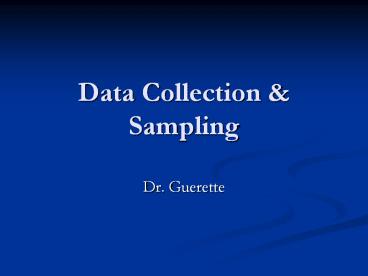Data Collection PowerPoint PPT Presentation
1 / 17
Title: Data Collection
1
Data Collection Sampling
- Dr. Guerette
2
Gathering Data
- Three ways a researcher collects data
- By asking questions
- By direct observation
- By using written records
- The fundamental issue in data collection is its
representativeness.
3
Logic of Probability Sampling
- Allows researchers to generalize to unobserved
cases. - Conscious and Unconscious Sampling Bias
- Bias in this case means that selections are not
typical or representative of the population from
which they are drawn. This could be result of
personal beliefs or many other reasons.
4
Logic of Probability Sampling
- Representativeness and Probability of Selection
- All members of a population have an equal chance
of being selected for a sample in probability
selections.
5
Probability Theory Sampling Distribution
- Probability theory permits inferences about how
sampled data are distributed around the value
found in a larger population. - Sample Element
- The unit about which information is collected and
it provides the basis of analysis. It is the
grouping of study elements.
6
Probability Theory Sampling Distribution
- Population parameter
- The summary description of a given variable in
the population. - Sample statistic
- The summary description of a given variable in
the sample. - Sampling distribution
- The range of sample statistics that would be
obtained when many samples are selected.
7
From Sampling Distribution to Parameter Estimate
- Sampling frame
- A list of elements in the population
- Binomial variable
- A variable that has only two values
- Estimating sampling error
- When independent random samples are selected from
a population and sample statistics are calculated
from those samples they will be distributed
around the population parameter in a known way.
8
From Sampling Distribution to Parameter Estimate
- Standard error
- Is the way of estimating how closely the sample
statistics are clustered around the true value. - Confidence levels and Confidence Intervals
- Use probability theory to indicate sample
estimates that fall within one, two or three
standard errors of the parameter.
9
(No Transcript)
10
Standard Error Diagram
Source Jeremy Kemp (2005)
11
- SE vp(1-p)/n
- Or
- SE vp x q/n
12
In Class Exercise Probability Sampling
- You have selected a probability sample and want
to determine the sampling error in order to
estimate the population parameter. In your sample
you compute that 70 percent of your sample
opposes establishing a hurricane relief fund
derived from Miami-Dade tax dollars, while 30
percent favor such a fund. You had a sample of
400 (N 400). - Report your confidence level and confidence
interval.
13
Probability Sampling
- Simple random sampling
- All elements in the population have an equal
chance of being selected for the sample. - Systematic sampling
- Drawing a sample of every Nth element in the
population. - Stratified sampling
- Based upon prior knowledge of a population, a
sample is drawn that will offer a greater degree
of representativeness.
14
Probability Sampling
- Disproportionate Stratified Sampling
- Specifically produce samples that are not
representative of a population on some variable. - Multistage Cluster Sampling
- Used when populations cannot easily be listed for
sampling purposes. Generally involves geographic
dispersion. While this technique increases
efficiency it decreases accuracy.
15
Probability Sampling
- Multistage Cluster Sampling with Stratification
- Used to increase the homogeneity of the sample.
16
Non-Probability Sampling
- Used when the likelihood of any given element
will be selected is not known (e.g. when random
probability sampling is not possible). - Purposive or Judgemental Sampling
- Selection based upon prior knowledge of the
population. - Quota sampling
- Uses a matrix or table to describe the
characteristics of the population and the sample
is drawn to reflect the cells of the matrix.
17
Non-Probability Sampling
- Reliance on available subjects
- Using people that are readily available seldom
produces data that have great value. - Snowball Sampling
- Begins by identifying a single member of a
population and then having that subject identify
others like him/her.

